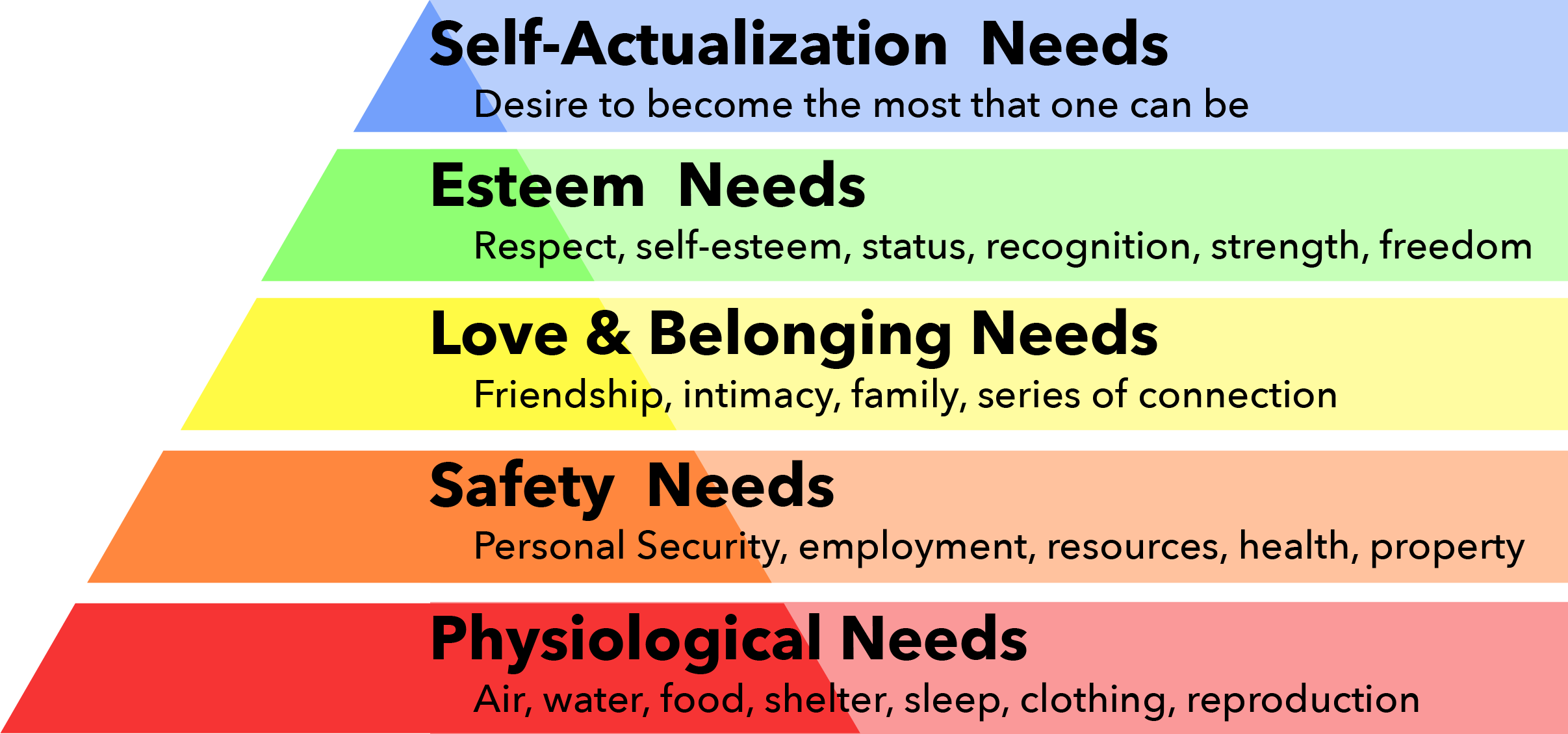Abraham Maslow was a humanistic psychologist, who approached the study of personality psychology by focusing on subjective experiences and free will. He was mainly concerned with an individual’s innate drive towards self-actualization – a state of fulfilment in which a person is achieving at his or her highest level of capability.
Maslow set up a hierarchy of 5 levels of basic needs. In the levels of the 5 basic needs, the person does not feel the second need until the demands of the first have been satisfied or the third until the second has been satisfied and so on.

Maslow’s basic needs are as follows in sequential order:
A)
Physiological Needs: These are
biological needs which consist of needs for oxygen, food, water and a
relatively constant body temperature. They are strongest and would come first
in the person’s search for satisfaction.
B)
Safety Needs: These are second active ones.
Adults have little awareness of their security needs except in times of
emergency or periods of disorganization in the social structure (such as in
case of communal riots). Consequently, children often display signs of
insecurity and the need to be safe.
C)
Needs for Love, Affection and Belongingness: Maslow
stated that people seek to overcome feelings of loneliness and alienation.
D)
Needs for Esteem: Humans have a need for a
stable, firmly based, high level of self-respect and respect from other. When
these needs are satisfied, the person feels self-confident and valuable as a
person in the world.
E) Needs for Self-actualization: Maslow described self-actualization as a person’s need to be and do that which the person was “born to do”. A musician must make music, an artist must paint and a poet must write.
) Homeostasis or Deficiency Needs: The first four levels are considered deficiency or deprivation needs (D-needs) in that their lack of satisfaction causes a deficiency that motivates people to meet these needs. Maslow also talks about these levels in terms of homeostasis.
Homeostasis
is the principle by which our furnace thermostat operates, i.e. when it get too
cold, it switches the heat on and when it gets too hot, it switches the heat
off.
Maslow sees all these needs as essentially for survival needs.
) Growth Needs: Maslow stated that every individual would like to reach the stage of self-actualisation, which is the last stage in Maslow’s hierarchy of needs. He used a variety of terms to refer to this level and he has called this as Growth Motivation in contrast to Deficit Motivation. That is, there are certain needs which contribute to the growth and development of the person, and these are called as “Being Needs” (B- Needs), which is in contrast to D-needs and self-actualization.
) Self-Actualizers: The kind of people whose needs do not involve balance or homeostasis, they likely to become stronger and continuous desire to fulfil potentials as a matter of becoming the most complete, the fullest are called Self-Actualization.
Qualities
of Self-Actualizers:
1) They enjoyed Solitude and were comfortable being alone.
2) They had an unhostile sense of humor.
3) They had a quality called “Acceptance of Self”.
4) They had a sense of humility and respect towards others. Something,
Maslov called Democratic values – meaning that they were open to ethnic and individual variety, even treasuring
it.
5) People tend to have more peak experiences than the average person. A peak experience is one that takes us out of ourselves, that makes us feel very tiny, or very large, to some extent one with life or nature or God
There are several Flaws or imperfections in Self-Actualizers:
1)
They often suffered considerable anxiety and guilt.
2)
Some of them are Absent-minded and overly kind.
3) Some of them had unexpected moments of ruthlessness, surgical coldness and loss of humor.
Self-actualisers need the following in their lives in order to
be happy:
a)
Truth, rather than dishonesty.
b)
Goodness, rather than evil.
c)
Beauty, not ugliness or vulgarity.
d)
Unity, Wholeness and transcendence of opposites.
e)
Aliveness
f)
Uniqueness
g)
Perfection and Necessity
h)
Completion
i)
Justice and Order
j)
Simplicity
k)
Richness
l)
Effortlessness
m)
Playfulness
n)
Self-sufficiency
o) Meaningfulness
Abraham Maslow hoped that his efforts at describing the self-actualising person would eventually lead to a “Periodic Table” of the kinds of Qualities, Problems, pathologies and even Solutions characteristic of higher levels of Human potential.
Hello. Where did you get the image of Maslow's Hierarchy of Needs from? I would like to use it and cite the original source. Thanks.
ReplyDelete